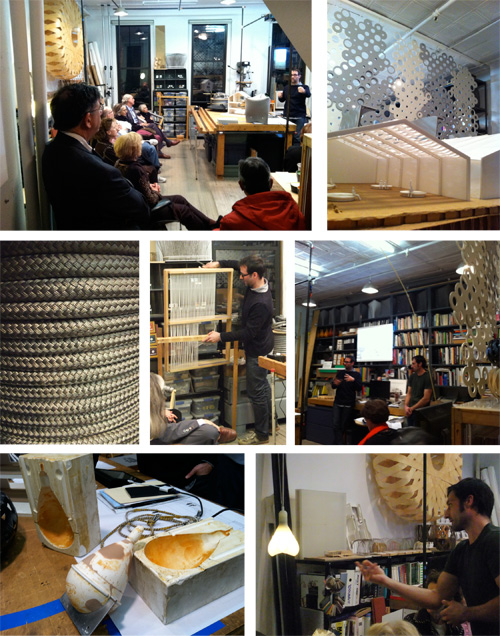DesignBoost NYC was a two-day design conference held at Cooper-Hewitt in June 2011. Thirteen speakers specializing in everything from biomechanics to filmmaking addressed the conference’s theme, “Design Beyond Design” in this series of short talks.
DesignBoost NYC was a two-day design conference held at Cooper-Hewitt in June 2011. Thirteen speakers specializing in everything from biomechanics to filmmaking addressed the conference’s theme, “Design Beyond Design” in this series of short talks.
Michael Bierut, this year’s winner of the Design Mind award, discusses the state of contemporary design with our National Design Awards winners: Tom Kundig, FAIA; Scott Stowell (OPEN); Ralph Rucci; Lucinda Sanders (OLIN); and Charles Harrison.
Join London-based design duo Nipa Doshi and Jonathan Levien in a conversation about their new furniture collection for Moroso that combines handmade and industrial production, a design approach that reflects a cross-cultural creative process. The discussion is moderated by Julie Lasky, Editor-In-Chief of I.D. Magazine.
Moorhead & Moorhead, brothers Granger and Robert, welcomed Cooper-Hewitt Members to their studio last evening. Their work explores issues of function and materiality, at scales ranging from furniture to architecture. An exploration of elasticity, the Rubber Lamp is a flexible silicone shell that flips up or down. Tape Wound Borne, featured in Design Life Now:...
The Shredded Collection Table (Fast Company Edition), made from 26 kilograms of Fast Company magazine. The Shredded Collection Console (White Edition), made from 5 kilograms of shredded confidential documents. Belgian industrial designer Jens Praet’s Shredded Series upcycles old magazines and paper into handcrafted furniture. According to Praet, “what started out as a research project...
Japanese Landscape in the Snow I was delighted by this New Year’s card from Takeshi Ishiguro in Tokyo. On the front was an image of a snow covered landscape, with one of those crisp blue skies that only seem to visit Japan when it’s cold. The card came in an envelope, as the postage stamps...
The 2010 Product Design award goes to Smart Design. Founded in 1980, Smart Design is led by Davin Stowell and Tom Dair. They are a multidisciplinary design consultancy, responsible for designing the OXO Good Grips kitchen tools, the SmartGauge instrument cluster for the Ford Fusion Hybrid, New York City taxi graphics, and medical devices for...
Ted Muehling, curator of Ted Muehling Selects: Lobmeyr Glass from the Permanent Collection invited Cooper-Hewitt’s Design Watch Members to his SoHo showroom for a private behind-the-scenes visit. On this rainy Monday, Members passed the noisy construction on Howard Street, left their umbrellas by the door, and retreated into a haven of design. As Members sipped...
I wish all children in the United States could know about design and have some experience of it before they reach high school age, and that design could be an option in the curriculum during the high school years, so that they could be aware of the value of design thinking in solving problems, or...
Industrial designers Masamichi Udagawa and Sigi Moeslinger are partners in the firm Antenna. Udagawa and Moeslinger create functional products for complex systems. For the 2003 Triennial (Inside Design Now), Antenna created a shower of cherry blossoms. Petals float and cluster in relation to the number of visitors traversing the Museum's grand staircase, creating a satisfying...
Two Volume Set, The Story of Eames Furniture This is my favorite design book from 2010. Yes, it’s huge! That’s a twelve inch ruler in the photo. It runs to 800 gloriously printed pages containing over 2,500 images, with a sturdy box to protect the volumes. Congratulations to Gestalten for such a superb production! And...
As the Smithsonian’s National Design Museum, Cooper-Hewitt seeks to acquire the best examples of industrial design, and much of the permanent collection has been built through the generosity of donors. The Museum would like to invite the public to help expand its holdings of products by Apple, one of the country’s most important and influential...
Gary Hustwit’s latest film, Objectified is playing at the IFC downtown for a limited run. Hustwit himself is seemingly traveling along with the film to nearly fifty venues between now and mid-summer, so both he and the film are likely coming to a venue near you if you happen not to be in New York....
Fernando and Humberto Campana grew up in Brotas, Brasil, 235 kilometers (146 miles) north of São Paulo. When the Campanas were growing up it was a small town that was renowned for its exuberant natural features and good soil for growing coffee. “Brotas is home, it is where everything began. We had very little to...













